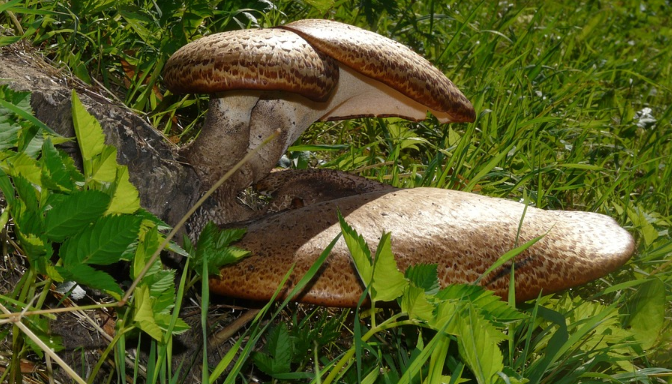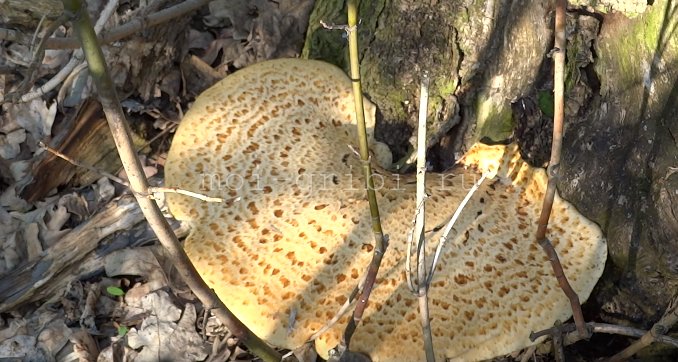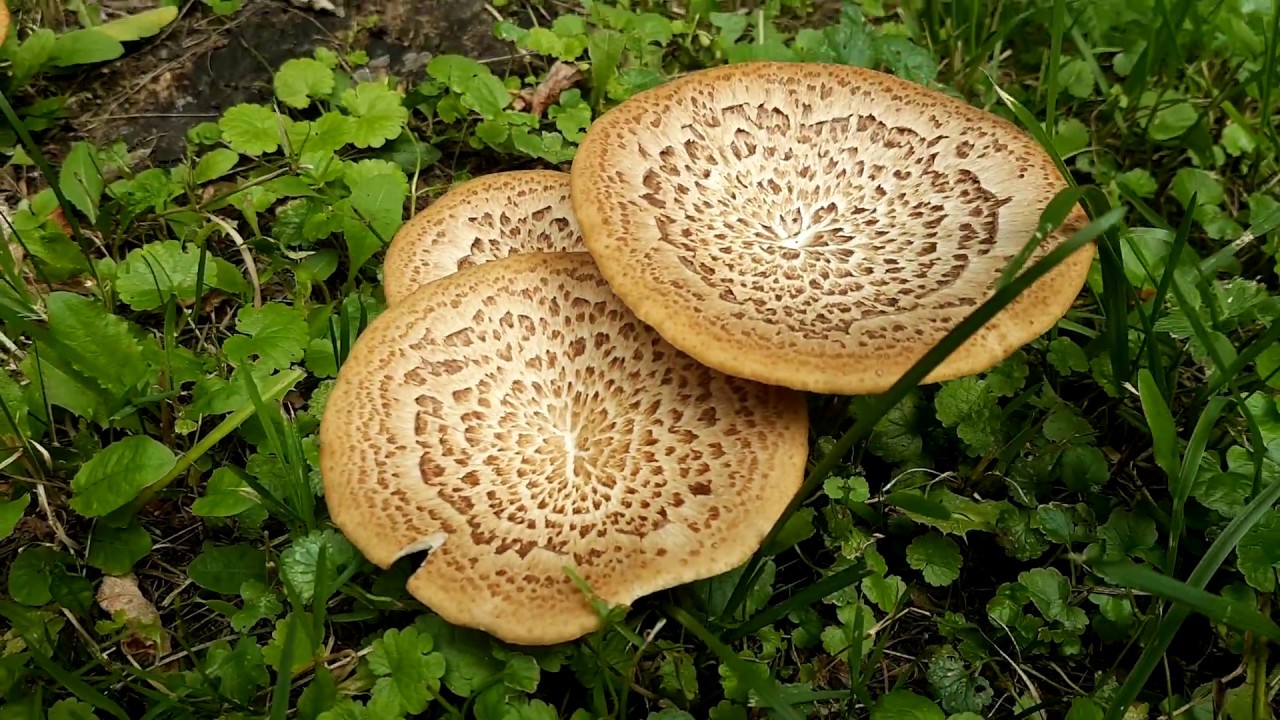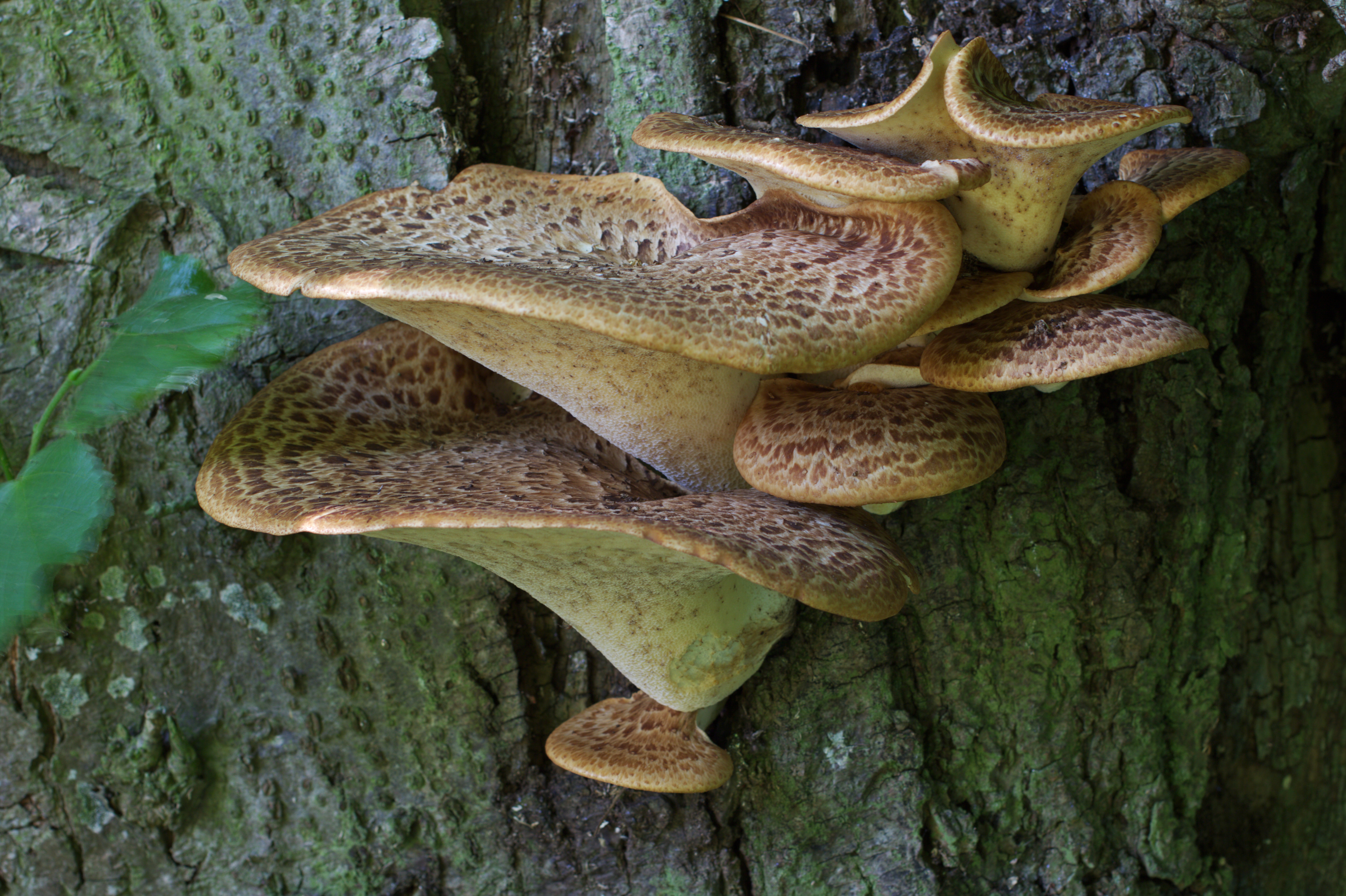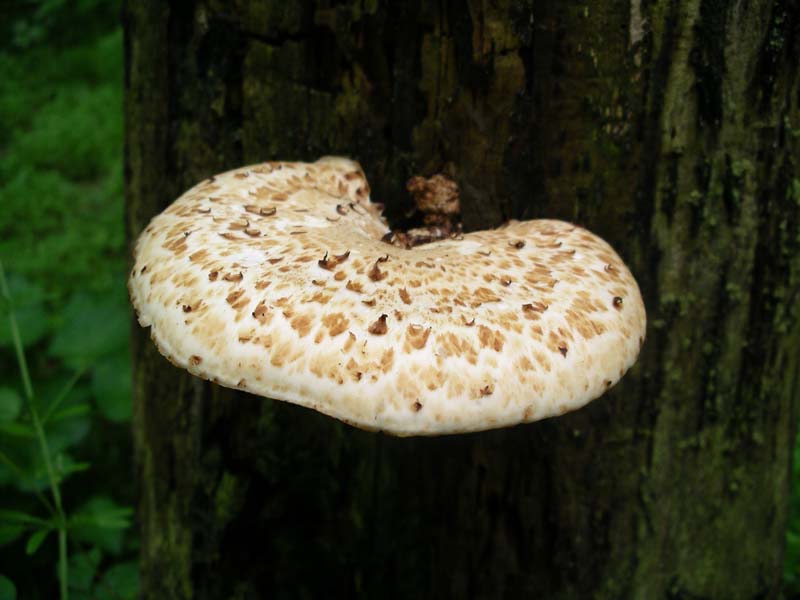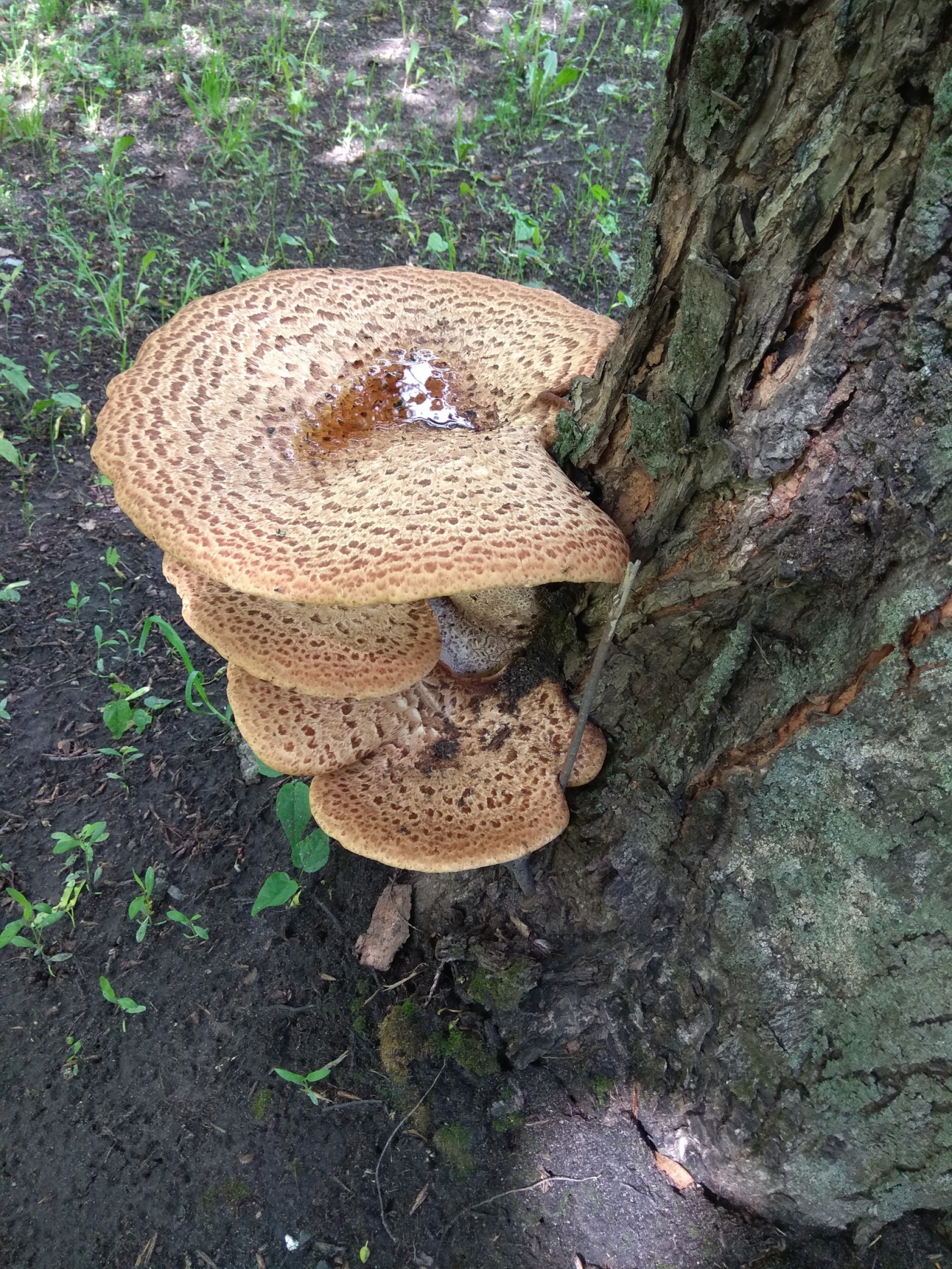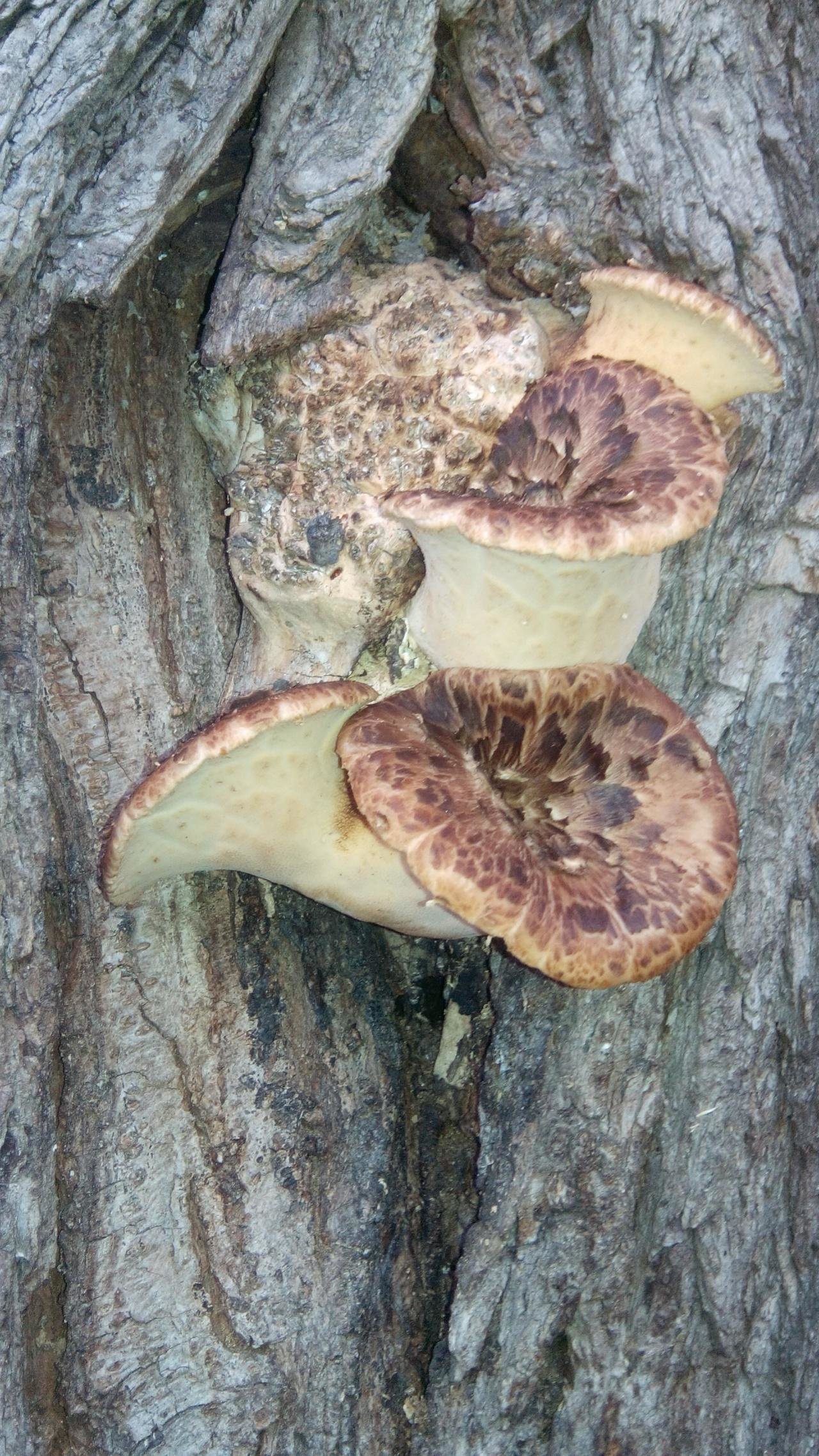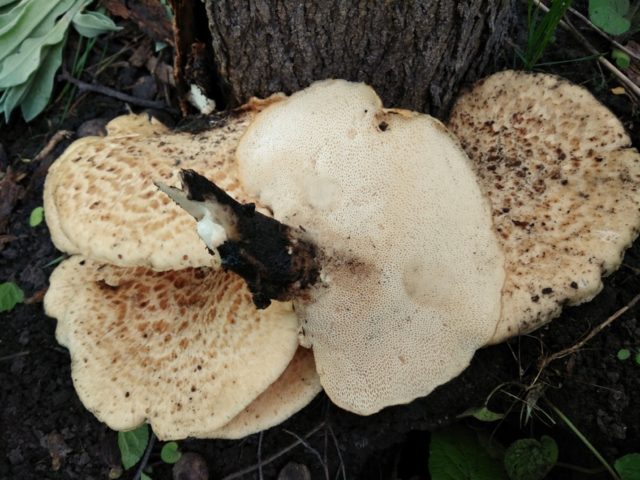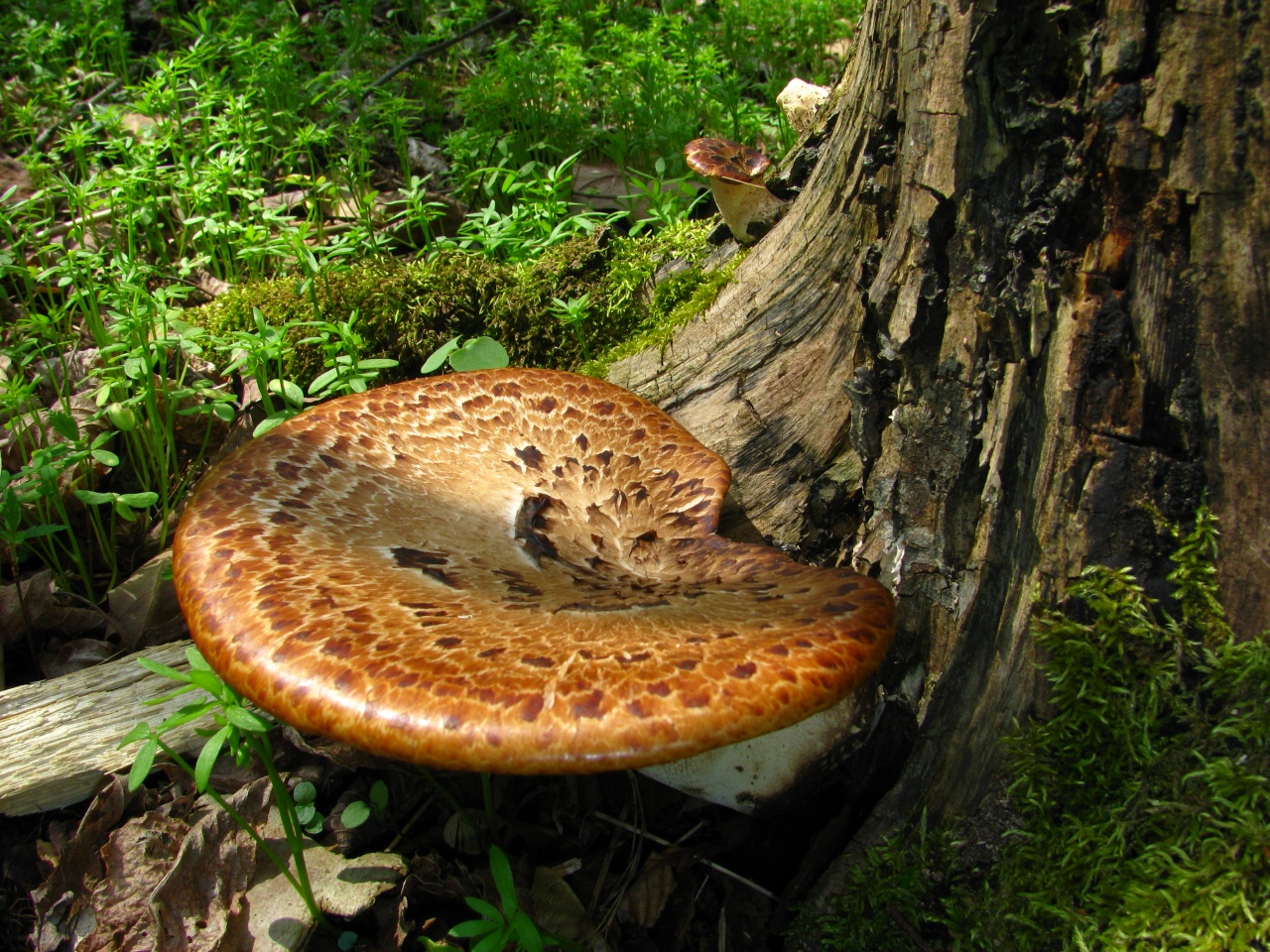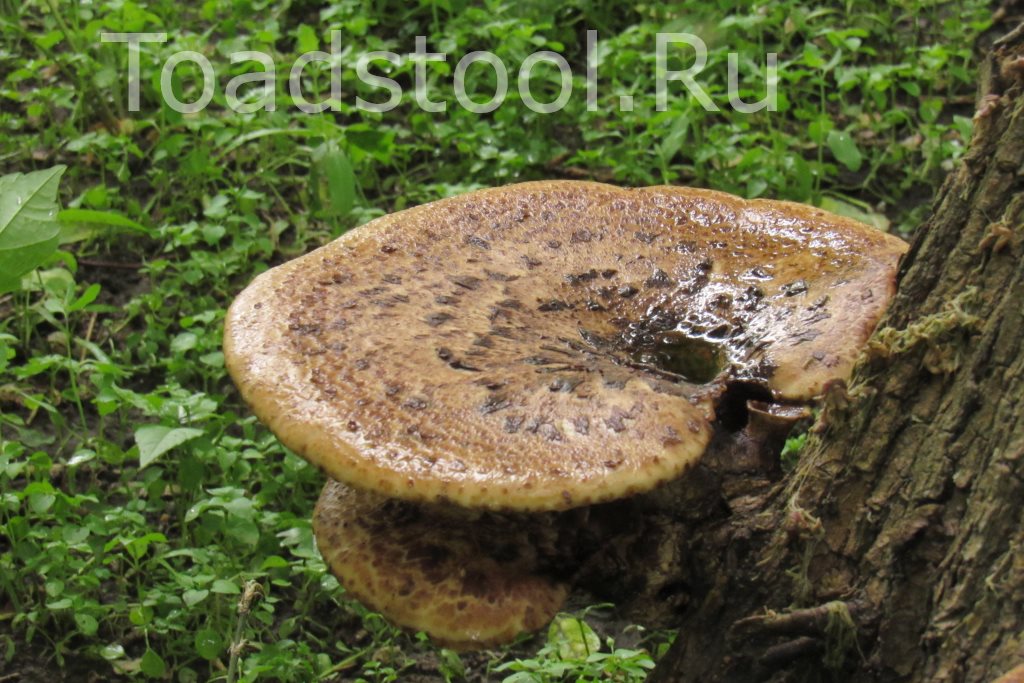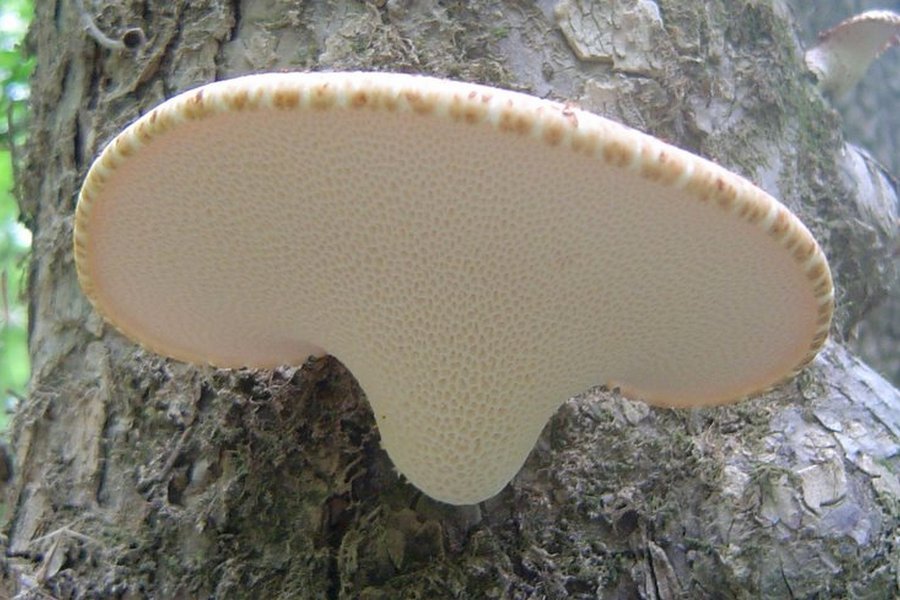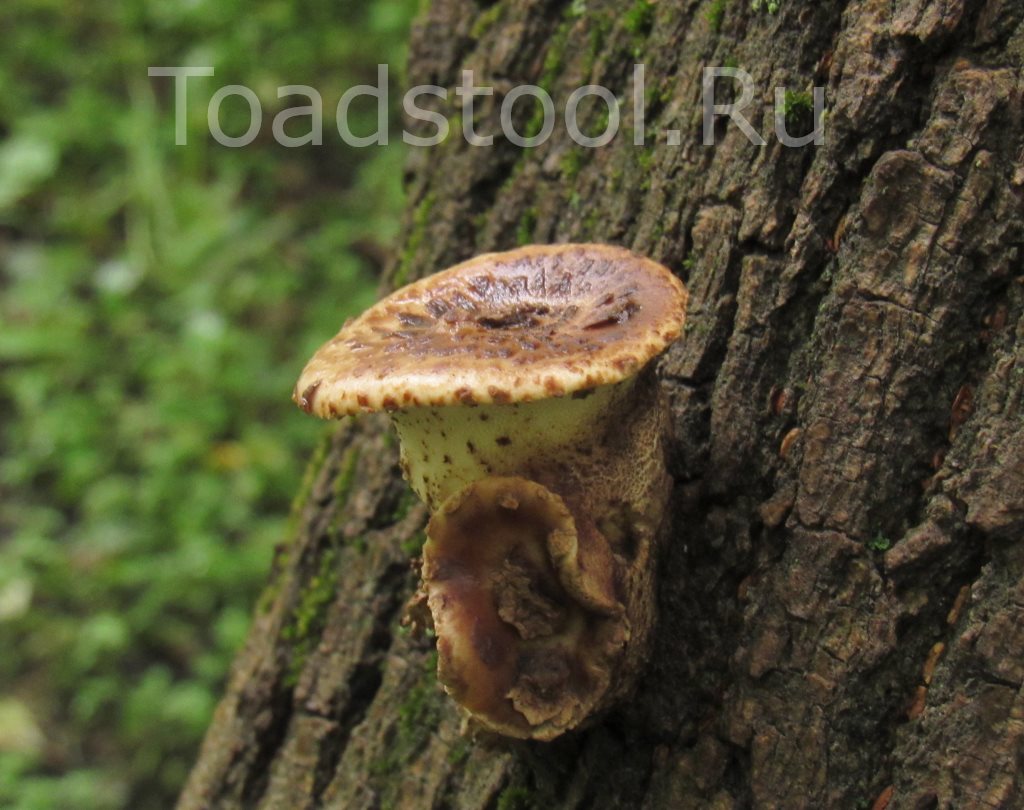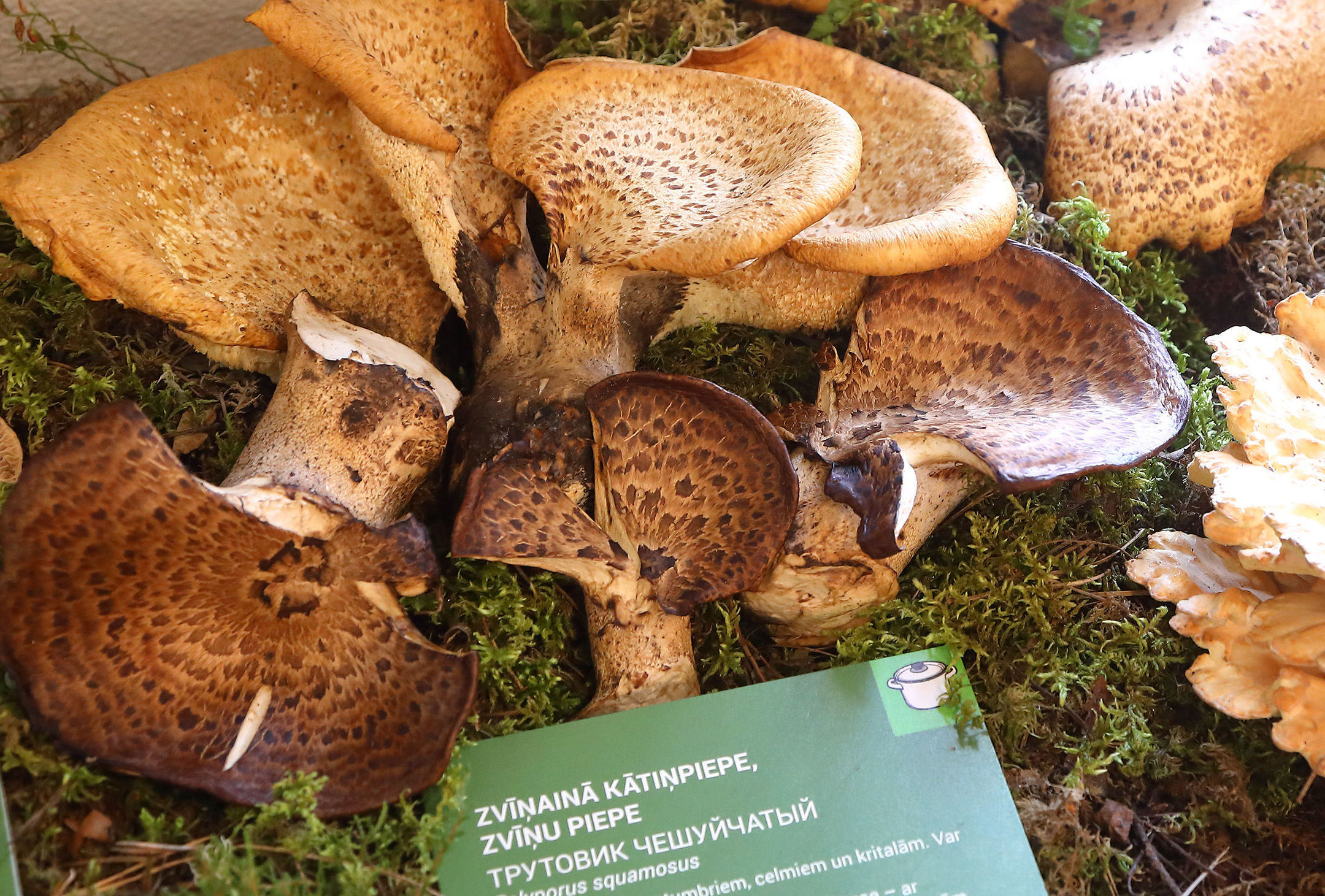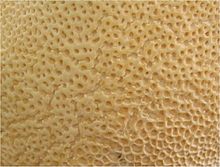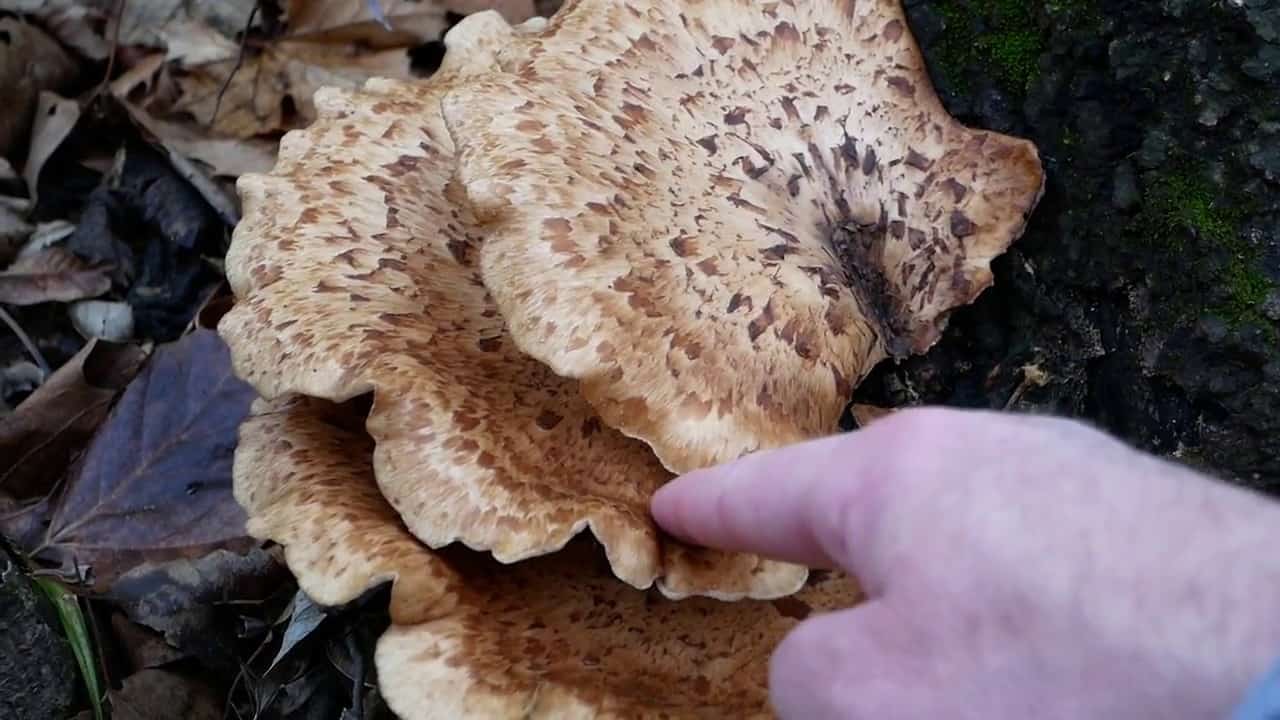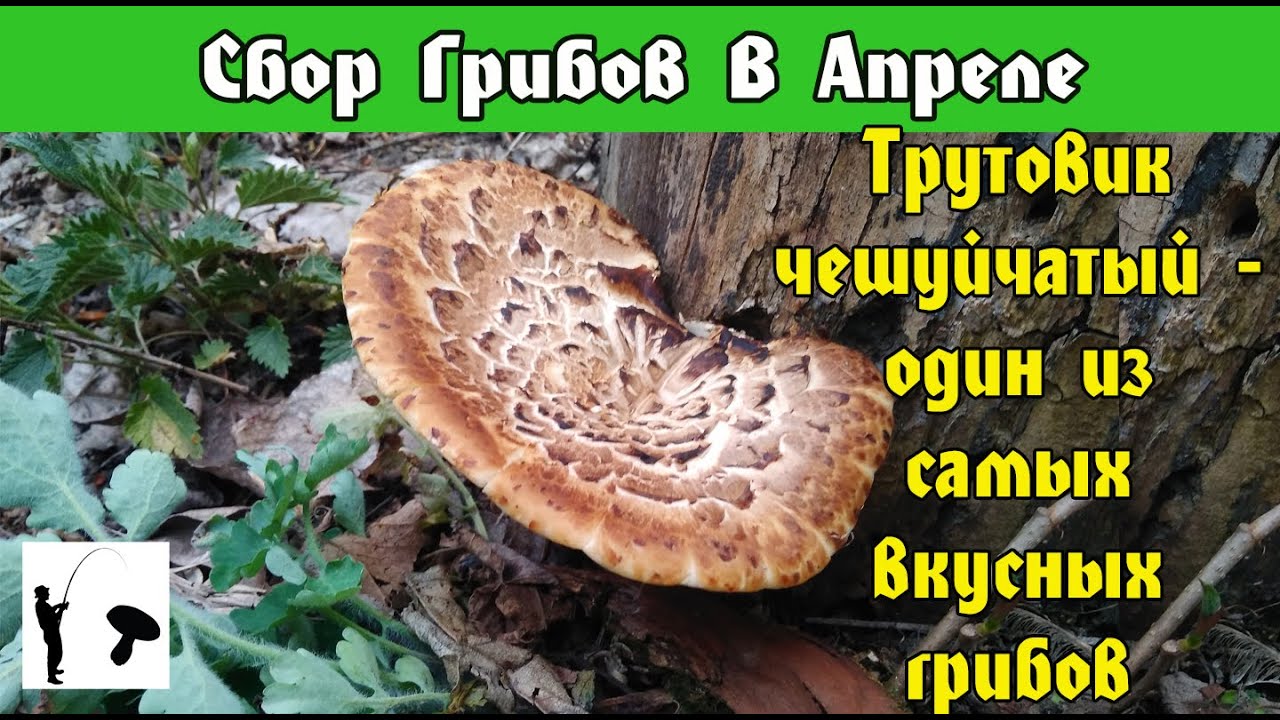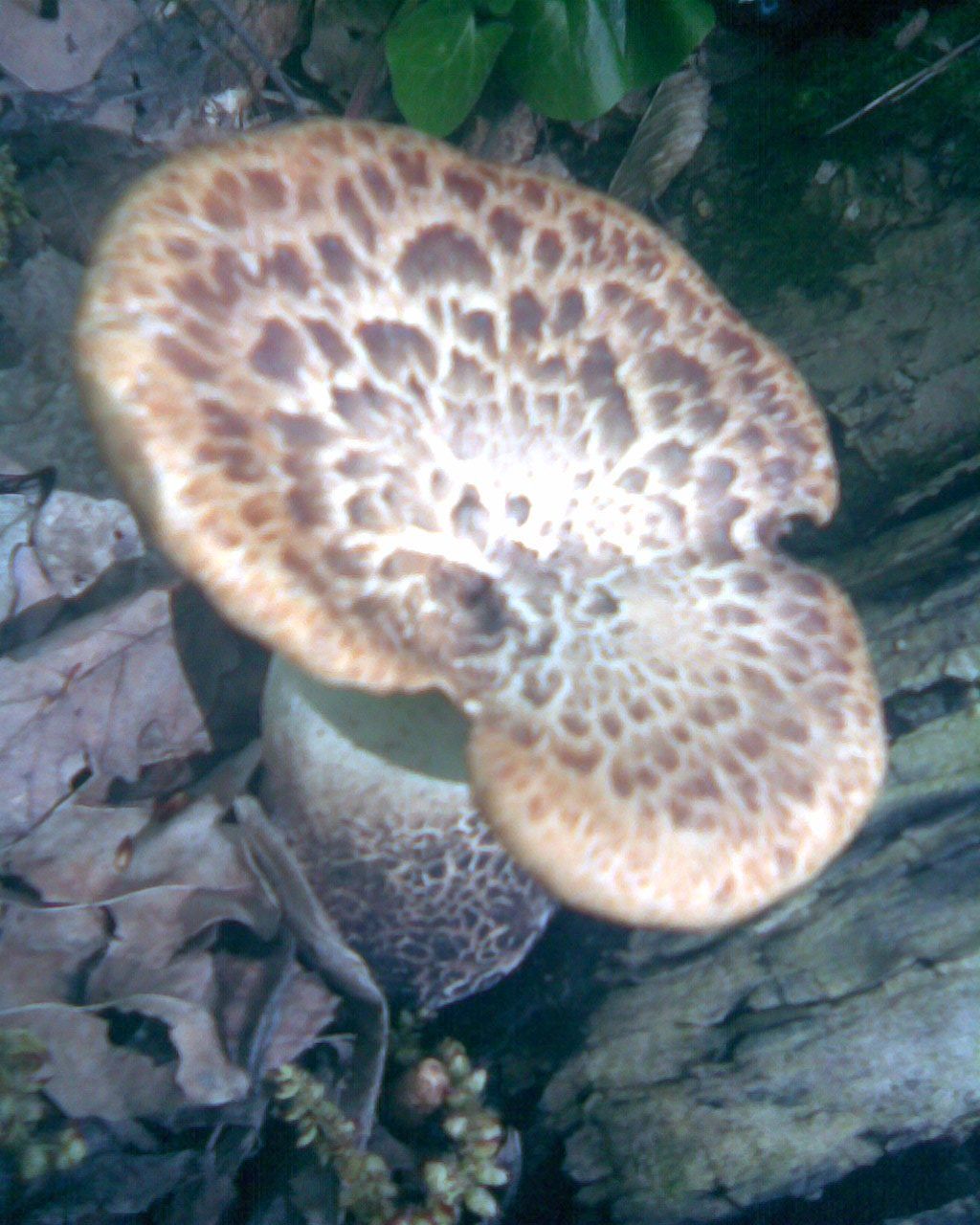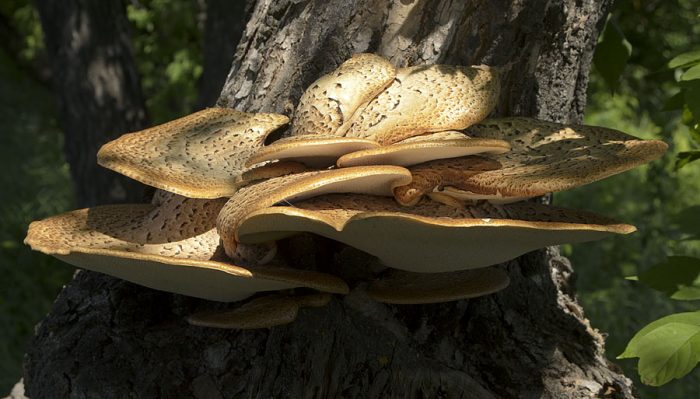Description of scaly tinder fungus
Fruit bodies are annual, usually located not high above the ground on tree trunks. The cap is fleshy, asymmetric, up to 30 (less often up to 40) cm in diameter, at first reniform, later prostrate, often somewhat depressed at the base. The edge is thin, curved and lowered. The pulp is soft, later hard, spongy corky, crumbling; with a mealy pleasant smell. The color of the cap is light yellowish, grayish. On the entire surface there are dark brown scales arranged in waves.
The hymenophore is tubular, light (white, yellowish), with large angular cells. Caps usually grow on stumps and trees in groups. Spores are white.
Leg up to 10 cm long, up to 4 cm thick, eccentric, dense; in the upper part reticular, whitish; brown-black at the base.
Similar species
Due to its specific appearance (shape and size of the cap, its “scaly” surface), the scaly tinder fungus cannot be confused with other mushrooms.
Spreading
Widespread species, from the east of the Rocky Mountains to the United States and throughout Europe. Usually fruiting bodies develop in spring, less often in autumn, sometimes in summer.
Edibility and application practice
Though P. squamosus usually non-toxic, it is not considered edible, except in very young and delicate specimens. Cookbooks recommend using young mushrooms finely chopped after a long period of boiling.
See what "Scaly Tinder" is in other dictionaries:
Scaly polypore, elm - Polyporus squamosus Huds ex Fr see also Genus Polyporus Mich. ex. Fr. Scaly polypore, elm P. squamosus Huds ex Fr. The hat is 5-30 cm in diameter, 0.5-6 cm thick, first round, then kidney-shaped or fan-shaped, ... ... Mushrooms of Russia. Directory
ROT WHITE TUNGA HEART-SHAPED; Scaly tart on the tung - English white heart rot of tung oil tree German Weißkernfäule, Holzölbaum French courriture blanche de l alévrite (de la moelle) pathogen: Polyporus squamosus Huds. see ... Phytopathological dictionary-reference
Tinder fungus sulfur-yellow - Laetiporus sulphurous (Fr.) Bond et Sing see also Genus Letiporus Laetiporus Msht. Sulfur yellow polypore L. sulphurous (Fr.) Bond et Sing A cap up to 40 cm in diameter, 14 cm thick, sessile or on a short stalk, often grows together in ... ... Mushrooms of Russia. Directory
Sheep polypore, sheep mushroom - Albatrellus ovinus (Fr.) Murr see also Genus albatrellus Albatrellus S.F. Gray Sheep polypore, sheep mushroom A. ovinus (Fr.) Murr. The hat is 5-10 cm in diameter, 1 2 cm thick, first convex with a bent edge, then flat, rounded, or ... ... Mushrooms of Russia. Directory
Griffin umbrella, branched tinder fungus - Grifola umbellate (Fr.) Pil see also Griffola genus Grifola S.F. Gray RED BOOK Gryphola umbellate, branched tinder fungus G. umbellate (Fr.) Pil. Fruit bodies reach 50 cm in diameter and weigh up to 4 kg and consist of numerous ... ... Mushrooms of Russia. Directory
Polypores - Paraphyletic group of mushrooms Multicolored polypore ... Wikipedia
Polyporous (family) - This term has other meanings, see Polyporous. ? Polyporous (family) ... Wikipedia
ORDER NON-PLATE, APHYLLOPHORALES Representatives of the order are characterized by fruit bodies of various shapes, sizes, consistency and color and various structures of the hymenophore, except for the lamellar one. An exception is the genus Lenzites with radial ... ... Mushrooms of Russia. Directory
Polyporus changeable - Polyporus varius Fr see also Genus polyporus Polyporus Mich. ex. Fr. Polylorus changeable P. varius Fr. The cap is fleshy-skinned, later corky-woody, 3-10 cm in diameter, flat or funnel-concave at the point of attachment of the stem, ... ... Mushrooms of Russia. Directory
Application
The elm tree is used for cooking. And also in the production of drugs for traditional medicine and the manufacture of decoctions, infusions and tinctures for traditional methods of treatment.
Cooking use
The cooking process begins immediately after collection. Regardless of what kind of dish you are going to cook, pre-soak the mushrooms for 6-12 hours. Refresh the water every hour.After soaking, the mushrooms are finely chopped, the legs are removed and boiled for 40 minutes, then peeled from the skin and scales.
Scaly tinder fungus is able to complement any dish. A properly prepared pestle is stored in the refrigerator for a long time and does not lose its taste.
Soup
Boil the chicken broth, throw the mushroom stock to them, and boil together for another 15 minutes. After a quarter of an hour, add potatoes, carrots and cereals (optional) to the broth. The hot dish is complemented with spices to taste: pepper, salt, lavrushka. Add greens (optional) and butter 2 minutes before the end.
Stewed mushrooms in sour cream
Cut the onion into half rings and fry in a pan until golden brown. Pour the cooked tinder fungus into the roast. Fry lightly over medium heat - be careful not to burn the onions. Then add sour cream, black pepper and salt to your taste. Simmer covered over low heat for about 15 minutes, stirring occasionally.
In medicine
The list of diseases for which therapeutic agents based on scaly tinder fungus are used is quite extensive:
- diseases of the bronchi and lungs (tuberculosis, pneumonia, bronchitis);
- dysfunction of the kidneys and bladder;
- oncology;
- gout;
- problems with the work of the pancreas;
- liver pathology;
- intoxication of the body;
- ulcer and gastritis;
- obesity.
Traditional medicine recipes:
- Dysbacteriosis, constipation and wound healing. The treatment is carried out using a powder, which is obtained by grinding the mushroom. In case of dysbiosis and constipation - eat a pinch of powder in the morning with ½ glass of warm water. The course of treatment is a week. In case of wounds, sprinkle sore spots, bandage, change the bandage 2 times a day until complete healing.
- Malignant neoplasms. A pinch of powder is added to 400 ml of boiling water, boiled for 20 minutes, filtered. Drink 1 tbsp. l. 3 times a day.
- Cleansing the blood. 5 g of powder for the first 2 days, washed down with 100 ml of water with an interval of 2.5 hours 10 minutes before meals. On day 3, switch to a three-time reception. The duration of the course is 1-2 months.
- Hepatitis. Soak the powder for 4 hours, mince. Leave 200 g of raw materials in a glass of boiled water for 2 days in a dark place. Strain, mix with water in which the mushroom has been soaked. Drink 10 ml 3 times a day for 3 months.
- Insomnia. Pour 180 g of powder with 500 ml of vodka, leave for 3 days, strain. An hour before bedtime 1 tsp. Dissolve the tinctures in ½ glass of water and drink.
- Slimming. Dissolve 2.5 g of powder in 100 ml of water. I take the resulting product 2 times a day on an empty stomach 30 minutes before meals.
- Psoriasis. Dilute 100 g of powder in ½ liter of boiling water, let it brew in a thermos for 6 hours, strain. Twice a day, moisten the bandage in the resulting product and apply to sore spots.
- Diseases of blood vessels and heart. 2 tsp Pour 250 ml of warm boiled water over powdered raw materials. Leave for 2 days, then filter. Take 1 tbsp. l. three times a day 30 minutes before meals.
Scaly tinder fungus has a lot of healing properties, but no less contraindications, which are important to pay attention to. If there is a need for treatment, when choosing a drug or a folk recipe based on a mushroom, consult your doctor. With proper collection, preparation and storage, you can make your diet more varied and useful.
With proper collection, preparation and storage, you can make your diet more varied and healthy.
Contraindications
Professional mushroom pickers advise not to experiment with medicines that have been prepared on the basis of tinder fungus, because they can cause an allergic reaction in the form of a skin rash. The mushroom in question has a mild laxative effect, therefore, when treating liver diseases, it is not recommended to use it for diarrhea, so as not to worsen your own well-being. For people suffering from urolithiasis, such recipes will not help either - the existing health troubles will only intensify, and the ailments that bother you will not disappear anywhere. Also, the main contraindication is the period of pregnancy (especially the last months) and breastfeeding.
If the selected formulations are improperly prepared, then they will also adversely affect the patient in the form of dizziness, nausea and vomiting. In any case, it is worth being treated with a tinder fungus only under the strict supervision of a personal doctor.
It is forbidden to use antibiotics and other potent drugs during treatment with a fungus. It is worth adjusting your usual diet, since during this period the patient is contraindicated in meat products (smoked meats and sausages, pickles), fatty broths, hot sauces, seasonings and spices, strong black tea and coffee in large quantities. Now the menu should be dairy-vegetable, with strict adherence to the dosage.
As for the tinder fungus, there are still active disputes: can this mushroom be considered edible or everyone risks poisoning it, is it suitable for medicinal tinctures or does it give absolutely no effect? This family has hundreds of species that differ in appearance and structure of the pulp, which means that the principle of application for each option should not duplicate other recommendations. If you use a tinder fungus under the close supervision of an experienced doctor, then the beneficial components of the mushroom can really help improve your health at home.
Common types of tinder fungus
Currently, several dozen species of these fungi have been described. They are quite widespread, because in most cases they are unpretentious to living conditions - wherever there is a sufficient number of deciduous trees, tinder fungus will inevitably settle. These mushrooms are found in Russia from the European part to Siberia and the Far East, everywhere in Europe and the USA. They prefer a temperate climate, so they are not widely distributed in tropical latitudes.
Below are several types that are most often found in our country. The edible varieties come first.
Tinder fungus sulfur-yellow
This species has a beautiful bright yellow coloration. It always grows in groups and is found in our country only in the European part. Most of all he loves to settle on oaks, cherries, poplars, mountain ash and beeches. A characteristic feature - the family of mushrooms resembles polyurethane foam frozen on the bark of a tree.
You can take mushrooms at once with a whole nest, and it is too large, it is better not to use old representatives
And one more important rule of collection - if sulfur-yellow tinder fungi from deciduous trees are absolutely safe, then it is better not to collect them from conifers - there is an insignificant chance of mild poisoning
IT IS INTERESTING
Tinder fungus sulfur-yellow
Liverwort ordinary
The hat resembles a liver in color, which is why the mushroom got this name. He also prefers the climate of the European territory of Russia, especially often settling under oak or chestnut trees.
Only young liverwort is eaten. It has a pleasant taste with a slight sourness. Most often it is fried or stewed with onions and potatoes, like other mushrooms.
Scaly tinder fungus (variegated)
This species has a soft and rather thick cap. Unlike many other polypores, it even has a leg, so it looks like a normal mushroom. It grows in the middle zone of our country. It is quite common in birch forests and grows even in the most unfavorable seasons due to its unpretentiousness.
However, mushroom pickers rarely take it as the flesh is quite tough. Most often it is consumed after prolonged cooking.
Scaly tinder fungus (variegated)
Umbrella polypore
It is rarely found in our country, but in neighboring China it is a very popular mushroom. It has small fruiting bodies, which, however, always grow in large families. It got its name from the umbrella-like hat.
Mainly prefers a mild climate and oak, beech, hornbeam forests. Along with the cap, it has a leg that resembles a rolled tube. In Chinese cuisine, it is consumed both fried and boiled.
The inedible species of this mushroom are listed below.
False tinder
Unlike the real one, it is very tenaciously attached to the tree trunk. Has gray, beige and brown (sometimes rusty) shades of the fruiting body. This mushroom has no legs at all, and the cap is quite large - with age it reaches 25 cm in diameter.
Lacquered polypore
This mushroom has a very beautiful fruiting body, reminiscent in color of strongly brewed tea. Its surface is glossy and gleams in the sun, which is why the look got its name. It is best known in China, Korea and Japan, where it has even been nicknamed the "mushroom of immortality" because its extracts are used in local folk medicine.
Lacquered polypore
Tinder fungus multicolored
And this species has a hat of exceptional beauty. It consists of multi-colored semicircles of light shades and different widths - green, orange, red, yellow and even lilac. Unlike many others, this species is not a parasite and most often feeds only on dead trees.
Polyporus varius: photo and description
| Name: | Tinder fungus |
| Latin name: | Cerioporus varius |
| Type of: | Inedible |
| Synonyms: | Polyporus varius. |
| Specifications: | |
| Systematics: |
|
Tinder fungus (Cerioporus varius) is a representative of the Polyporovye family, the genus Cerioporus. A synonym for this name is Polyporus varius. This species is one of the most mysterious and poorly studied among all tinder fungi. Despite the very pleasant appearance and aroma, this specimen has no place in the general basket.
Description of the volatile polypore
The specimen has a pleasant mushroom aroma
The fruiting bodies of the tinder fungus are small, presented in the form of a small cap and a thin stem. The spores are smooth, cylindrical, and transparent. Spore white powder. Differs in elastic, thin and leathery pulp with a pleasant mushroom aroma.
Description of the hat
Spore-bearing layer finely porous, light ocher color
The cap in this specimen is spread with a deep central depression, reaches no more than 5 cm in diameter. At the initial stage of development, its edges are tucked up, and a little later they open. Painted in yellow-brown or ocher color, with time it acquires faded shades. The cap is smooth, fleshy in the center and thin at the edges; in old mushrooms, it is fibrous. In wet weather, the surface is shiny, sometimes radial stripes appear. On the inner side there are small tubes of light ocher color, slightly rolling down on the stem.
Leg description
The flesh of this specimen is firm, while the old ones are woody.
The leg of the tinder fungus is straight and rather long, up to 7 cm in height, and up to 8 mm thick. Expands slightly at the top. In most cases, it is located in the center, rarely eccentric. Velvety to the touch, especially at the base. The structure is dense and fibrous. Painted in black or dark brown.
Where and how it grows
The favorite habitats of the tinder fungus are deciduous forests, especially where birch, oak and beech grow. It is also quite common on stumps, fallen branches and the remains of trees of any species. It settles not only in the forest, but also in parks and gardens. Located on wood, this species thereby contributes to the appearance of white rot. The best time for fruiting is from July to October. As a rule, it grows in the temperate northern zone. However, it is found in different parts of not only Russia, but also abroad. It can grow both singly and in groups.
Is the mushroom edible or not
Tinder fungus belongs to the category of inedible mushrooms. Despite its pleasant aroma, it has no nutritional value.
The species in question is not poisonous, but due to its tough pulp, it is not suitable for food.
Doubles and their differences
Tinder fungus, changeable in appearance, is similar to the following gifts of the forest:
- Chestnut tinder fungus is inedible.The size of the fruiting body differs markedly from the variable one. So, the diameter of the double's hat varies from 15 to 25 cm. In addition, in this species, the leg is painted completely black. Quite often it can be found together with scaly tinder fungus.
- May tinder fungus is an inedible specimen that begins its development in May. The color of the tubes and the shape of the cap are similar to the species in question. You can distinguish a double by a gray-brown scaly leg.
- Winter tinder fungus - is considered inedible due to its tough pulp. The spore-bearing layer is finely porous, white or cream-colored. Despite the name, fruiting occurs from spring to autumn. The leg of this specimen is velvety, gray-brown, which is a distinguishing feature from the species in question. You can also recognize the double by the gray-brown or brown color of the cap.
Conclusion
Tinder fungus is a specimen that exhibits a radial pattern on the cap. It is quite easy to confuse it with some other polypores, but the distinguishing features are a tubular white layer, small pores, and a black and velvety stem at the base. In any case, all the varieties considered are not suitable for consumption, and therefore should not be included in the general basket for edible mushrooms.
Appearance and distribution area
Young scaly tinder fungus has a helmet-like shape, but over time it changes to a fan-shaped cap. The cap grows up to 30-40 cm in diameter, covered with black or brown scales, located in concentric circles. Has thin and downward-curving edges of the cap, sometimes they are serrated. The caps are rather thick, fleshy, and have a juicy flesh. When broken, they give off a pleasant smell, similar to the smell of a half-baked bun, sometimes completely honey. As the mushroom matures, the cap becomes harsh to the touch. Most often colored yellow. The bottom is tubular, yellowish or white.
The leg of the scaly tinder fungus reaches a thickness of up to 4 cm in diameter, and is short. In some cases, the length reaches 8-10 cm. By location, it is mostly lateral and never grows from the center. The shape of the leg can be either straight or curved. It is dense in mass, but upward turns into a mesh, porous and loose. As for the color of the mushroom leg, it has a white, cream or yellowish tone. The color of the base is brown with black, covered with dark scales over the entire surface.
The scaled polypore is a widespread species in the deciduous forests of North America and Europe. In Russia, it grows in the Krasnodar Territory, Stavropol Territory and the Crimea. It is also found in the North Caucasus. A separate subspecies of scaly tinder fungus is also found in the forests of Eastern Siberia, the Far East, and even in Kamchatka.
The fungus grows not only in forests but also in city parks, preferring weakened non-coniferous trees such as maple and sometimes beech. Most of all he loves to settle on an elm tree - hence its second name - an elm tree. Often, the mushroom grows in clusters, forming small colonies.
Back to content
Widespread tree fungus: characteristic of the scaly tinder fungus
The scaly tinder fungus can be called differently: elm, and variegated tinder fungus, and motley, and hare. In appearance, it resembles discs or plates that have grown into a tree trunk.
Usually grows low. Sometimes it reaches a height of up to 10-12 meters, or vice versa, they grow almost from the ground. Rotten stumps are perfect for the appearance of a scaly tinder fungus.
Appearance and distribution area
Young scaly tinder fungus has a helmet-like shape, but over time it changes to a fan-shaped cap. The cap grows up to 30-40 cm in diameter, covered with black or brown scales, located in concentric circles. It has thin and downward-curving edges of the cap, sometimes they are serrated. The caps are rather thick, fleshy, and have a juicy flesh.When broken, they give off a pleasant smell, similar to the smell of a half-baked bun, sometimes completely honey. As the mushroom matures, the cap becomes harsh to the touch. Most often colored yellow. The bottom is tubular, yellowish or white.
The leg of the scaly tinder fungus reaches a thickness of up to 4 cm in diameter, and is short. In some cases, the length reaches 8-10 cm. By location, it is mostly lateral and never grows from the center. The shape of the leg can be either straight or curved. It is dense in mass, but upward turns into a mesh, porous and loose. As for the color of the mushroom leg, it has a white, cream or yellowish tone. The color of the base is brown with black, covered with dark scales over the entire surface.
The scaled polypore is a widespread species in the deciduous forests of North America and Europe. In Russia, it grows in the Krasnodar Territory, Stavropol Territory and the Crimea. It is also found in the North Caucasus. A separate subspecies of scaly tinder fungus is also found in the forests of Eastern Siberia, the Far East, and even in Kamchatka.
The fungus grows not only in forests but also in city parks, preferring weakened non-coniferous trees such as maple and sometimes beech. Most of all he loves to settle on an elm tree - hence its second name - an elm tree. Often, the mushroom grows in clusters, forming small colonies.
Medicinal properties
In official medicine, scaly tinder fungus is used in the basis of drugs. Mushroom medicine gives an excellent healing effect aimed at restoring organs that have been intoxicated with toxic substances. These can be common poisons, heavy metals like mercury and even gases like sarin.
The medicinal properties of the scaly tinder fungus are also used in folk medicine. For a long time, recipes for the preparation of dry anti-inflammatory extracts and ointments have been known, which inhibit the growth of pathogenic fungi that develop on human skin and under nails.
Medicinal ointments are prepared from scaly tinder fungus
You can eat, but only carefully!
Scaly tinder fungus is a conditionally edible fungus, and only when fresh. That is, harvested in the spring, when its pulp is soft and fleshy. Later, the pulp becomes tough, like an old cork, crumbles easily and loses its flavor.
You can prepare delicious and varied dishes from the mushroom. There are cooking recipes that allow you to both fry, salt, marinate and dry, as well as cook pies with them, add them to soups as a seasoning and much more.
The preparation of the scaly tinder fungus should be started immediately after returning from the forest: the first step is to soak the mushroom well for 12 hours, but it can be longer. In this case, the water changes every 1-1.5 hours. Regardless of what kind of dish you are going to cook, the mushroom should first be finely chopped, and then boiled well. It should be boiled for at least 40 minutes, then peeled from the skin with scales. An undercooked mushroom turns out to be quite hard and slightly sweet in taste, and even the abundant use of spices will not knock this sweetness down.
Before cooking, the scaly tinder fungus must be soaked for at least twelve hours.
Timely collected and properly prepared scaly tinder fungus has amazing taste. Having prepared a dish from it at least once, you can fall in love with these woody mushrooms for life!
Description of scaly tinder fungus, place of distribution, photo
Scaly polypores can be easily grown on their own both at home and in the country. This will require a substrate of sawdust, shavings and bark of branches.
The cultivation process consists of the following stages: Hemp or bars can act as a substrate on the site.
You need to make cuts in them with any convenient hand tool. Place the mycelium in the incisions. The substrate must contain a sufficient amount of moisture, therefore, it should also be soaked in water beforehand.
Tinder fungus beveled and leafy
Growing tinder fungus on your own can be considered advisable, since the mushroom gives quick yields and can be used both for culinary purposes and as a healing component in the menu.
The tinder fungus, like most mushrooms, has false counterparts. The differences between these species can be seen most clearly in the photo.
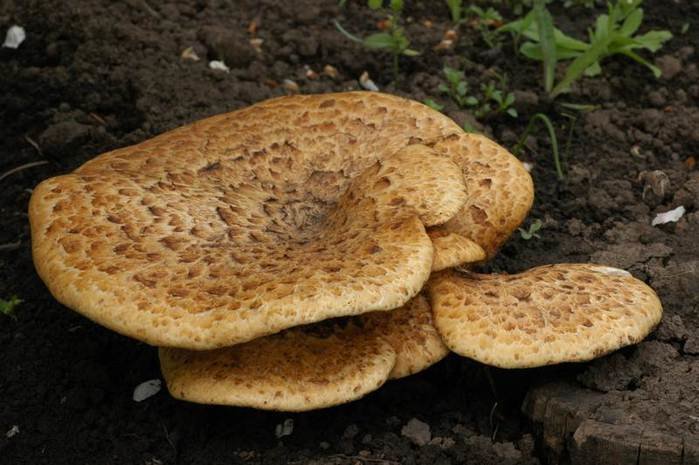
Cellular polypore is an edible relative of the scaly one. The difference lies in the brighter color of the cap - in the honeycomb tinder fungus, it is reddish-orange. Also, this mushroom, even at a young age, has a very tough fruit body, the flesh of a honeycomb tinder fungus has a very faint smell and an expressionless taste.
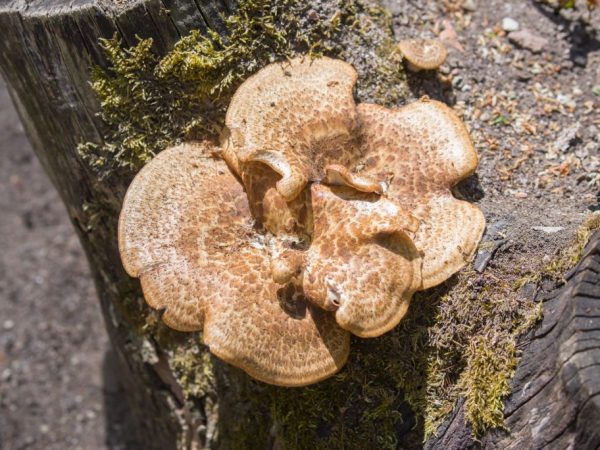
Liver mushroom - edible, with a delicate taste and a strong sour aftertaste. Usually grows in the lower part of the trunk or at the roots. It is distinguished by an unusually bright color of the pulp, reminiscent of meat with whitish veins.
It cannot cause direct harm to health.
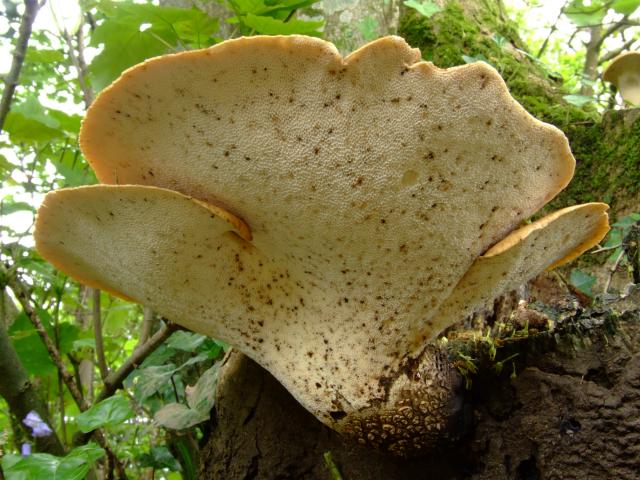
But due to the pungent, bitter, unpleasant taste and disgusting odor, it can cause stomach cramps caused by pronounced individual intolerance. Medicinal properties and contraindications, benefits and possible harm Eating polyporus in food helps to restore the body after poisoning with poisons and heavy metals.
Application
Due to the large number of useful properties, this representative of the Polyporovye family has found application both in cooking and in medicine.
Cooking use
Scaly tinder fungus is conditionally edible, belonging to the 4th food category. This means that it must be prepared before eating. First, it is soaked in water for at least 6 hours to soften, and then boiled for half an hour. During soaking, the water must be changed every hour.
Irina Selyutina (Biologist):
Despite the fact that the fruiting bodies of the scaly tinder fungus are annuals, only the young are eaten, the old are already becoming very tough. To please the family with a delicious polyporus dish, after collecting it, you need to soak it as soon as possible, otherwise it will become rusty. Although it is often written that this mushroom is soaked for 6 hours - this is the minimum, it is best to soak the polyporus for a day with a regular change of water every hour to remove its characteristic compounds. After soaking, the peel is removed from its surface and the hard legs are necessarily cut off. When boiling, for every 500 g of mushroom, take 3 liters of water.
The mushroom is suitable for all types of homemade preparations and perfectly complements any dish. Scaly tinder fungus can be stored for a long time in the refrigerator, it does not lose its taste for a long period of time.
In medicine
In official (traditional) medicine, on the basis of this mushroom, preparations are made for the recovery of patients after severe poisoning and the removal of toxic substances and toxins from the body. Scaly tinder fungus medications can neutralize light poisons and heavy compounds like mercury and poisonous gases like sarin.
In folk medicine, scaly tinder fungus is used to treat fungus. For a long time, there have been medicinal recipes for the manufacture of dry extracts and ointments that help relieve inflammation and fight the growth of fungal formations under the nails and on the surface of the skin. Even a simple regular use of this mushroom in food allows you to manifest to some extent its healing qualities.
Distribution and cultivation
Under natural conditions, allusions are found in mixed forest areas, where increased moisture levels are noted, reaching 90-95%. Referring to saprophytes, they prefer stumps and places near the roots of fallen trees. They grow in large colonies with several mushroom legs growing from a single base.
For culinary purposes, edible flakes are grown artificially.When breeding under artificial conditions on sawdust and substrates obtained from broad-leaved species, mainly beech, special shelters and the mandatory use of air humidifiers are required.


